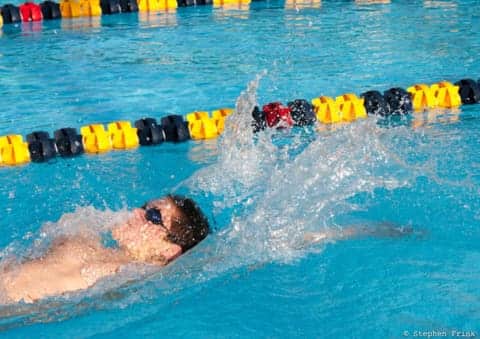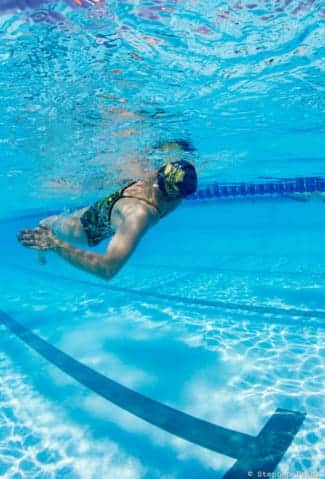Welcome back to our 3rd segment of our Backstroke Series!
Last week, we dove into the MAJOR difference between the Backstroke and Freestyle strokes. This week, we are going to discuss when to breathe during backstroke, and the benefits of a consistent breathing pattern.
In case you missed last week’s post, click here to learn about the major difference between the long-axis strokes!
Otherwise, let’s get started!
Most swimmers think that best Backstroke breathing pattern is to breathe whenever they need to. This common misconception comes from the fact that the Backstroke stroke allows a swimmer to breathe whenever they want, because it’s the only stroke where a swimmer’s face spends more time above the water, than under. This misconception has lead to many frustrations among swimmers, and the development of some technical bad habits.
The general rule for breathing during Backstroke is a swimmer should correlate their breathing pattern with their arm strokes. What this means is that when a swimmer is either pulling or recovering, their breathing will follow pattern of their arm cycle—similar to three other strokes.
In my opinion, the best backstroke breathing pattern is when a swimmer starts inhaling right before pinky entry on their right arm and continues inhaling through half of the right arm pull and then, they start exhaling (at that same point with their left arm)– right before entry and through half of the left arm pull. The swimmer should alternate between inhaling and exhaling at the same point, but on different arm strokes.

P.S., It does NOT matter which arm you chose to inhale or exhale with.
There’s a few reasons why I prefer this breathing pattern over a few others. Let’s take a look at them:
1.) It promotes a CONSISTENT breathing pattern!
In every stroke we swim, we are consistently breathing at a regular rate. There is NO reason Backstroke shouldn’t be the same. As humans, we must shuttle lactate out of our body and the only way to do that is by breathing. If you want to swim fast, you also need to learn the best pattern to breathe—for every stroke.
Not sure what lactate is, find more information on gas exchange here.
2.) There is LESS probability of water getting into your mouth!
Due to surface tension and the fact a swimmer’s face is out of the water, Backstrokers are always at constant risk of getting extra water into their mouth or nose. For a few brief moments after the arm exits the water (into the recovery), the water molecules will stick to the arm due to surface tension and then abruptly fall off. I’ve read and been instructed by many articles to breathe similar to how I described above–but only during the recovery phase. This breathing pattern does NOT account for surface tension.
Because surface tension is a real issue for Backstrokers, I advise my swimmers to wait until the hand has passed their head/mouth/nose (i.e. right before pinky entry) to inhale or exhale, so there is no added risk of getting water into their mouth, while they are trying to get air.
3.) It’s a GREAT pattern for ANY Backstroke distance!
A 50 Backstroke tempo is very different than a 200 Backstroke tempo. By sticking to this breathing pattern, a swimmer will consistently get air, AND shorten their inhale/exhales to adjust to their higher or lower tempo.
By shortening their inhales/exhales during shorter Backstroke events, this promotes a swimmer to not only have a consistent gas exchange, but to keep air in their lungs. This will help with body balance and leg lift while swimming.
Some of the other breathing patterns like–either inhaling or exhaling on every recovery of your right arm ONLY—doesn’t promote enough gas exchange and causes the swimmer to sink while swimming.

Overall, breathing consistently and in correlation with your arm strokes is the BEST breathing pattern in Backstroke. A swimmer should always wait to inhale or exhale until their arms have bypassed their mouth or nose to avoid inhaling any extra water.
Back to our subject…
Is this the breathing pattern you use?
If the answer to that is either a YES or NO, we want to hear from you. Be sure to comment below with your thoughts and ideas!
[CLICK HERE] for Part IV, as we will finish up our Backstroke series–discussing many of the common technical errors seen during the Backstroke stroke!
Thanks for tuning in!
Until Next Time,
Abbie Fish

2 Responses
I swam backstroke in high school (50 years ago) and basically had no instruction other than “you are our backstroker.” I breathed totally randomly. As I got older i eventually realized that breathing once per stroke was a better strategy.
Love hearing this and it’s so true! It’s not often talked about enough!